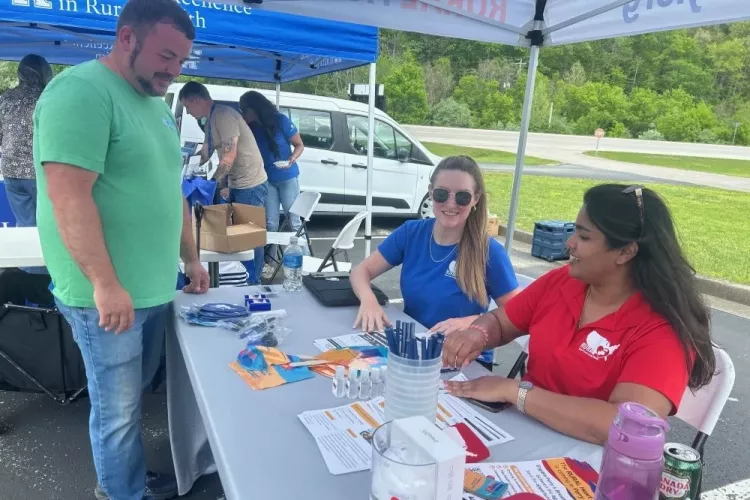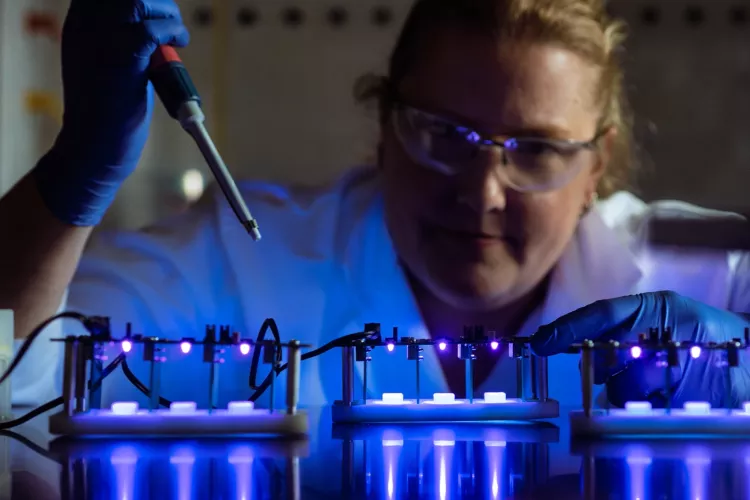Specialized nurses keep the focus on stroke care at UofL Hospital
October 2, 2024When a patient comes into the emergency room at University of Louisville Hospital with symptoms of a stroke, they benefit from a team of specially trained nurses dedicated to ensuring they receive the appropriate care quickly. In cases of stroke, time is brain.
As the state’s first Certified Comprehensive Stroke Center, UofL Hospital meets the highest standards of stroke care, and continually raises the bar. Prompt treatment with intravenous Alteplase (IV t-PA) is associated with better outcomes, lower mortality and shorter length of stay for patients with ischemic stroke. One of the key stroke treatment guidelines established by the American Heart Association and American Stroke Association is the administration of IV t-PA within 60 minutes of arrival at the hospital for patients with ischemic stroke. The staff at UofL Hospital continually works to improve this time, aiming to deliver IV t-PA to eligible patients within 45 minutes.
Deidra Gottbrath, RN, BSN, leads a team of specialized stroke clinical resource nurses on staff at UofL Hospital to help ensure that eligible stroke patients receive IV-tPA as quickly as possible. It can be challenging to determine whether a patient’s symptoms are due to a stroke or another condition. Gottbrath, who is certified in critical care and stroke care, provides the added resource to help expedite this process.
“From the moment we start participating in care, the ultimate focus becomes treating the stroke. That sounds simple, but there are a lot of complex cases that involve stroke symptoms,” Gottbrath said. “We don’t wait until we are sure it is a stroke before we apply that urgency. We focus on treating every case with stroke symptoms as though it is a stroke until we firmly rule out a stroke and let go of that urgency.”
Paula Gisler, RN, PhD, is director of the UofL Hospital Stroke Program and helped define the stroke clinical resource nurses’ role. “These nurses are a resource to patients and physicians to drive care for all stroke patients. They do whatever it takes to get stroke patients appropriate care to achieve the best outcomes.”
The stroke clinical resource nurse supports emergency room nurses to assess potential stroke patients, facilitate scans, get IV-tPA medication prepared, and work with family members. They keep lines of communication flowing among emergency room nurses, doctors, the stroke team, the radiology staff and other providers.
“We are the string that ties the story together so it makes a complete circle, rather than leaving threads that might be woven together later,” Gottbrath said. “Because we focus solely on that one patient and situation, because that is our priority, we can offer the resource of locating family members to get the full story to get the patient treatment.”
Gottbrath and the other stroke clinical resource nurses follow patients beyond the emergency room, advocating for patients and keeping the lines of communication open throughout their stay. They provide education for patients and their families, as well as bedside nurses who care for stroke patients outside of the stroke unit.
“We are involved in the daily discussions of what type of rehab is appropriate for a patient and communicating that back to the families,” Gottbrath said. “We are there from the scariest moment to looking forward to going home or to rehab. We see the full circle of care.”
Kerri Remmel, MD, PhD, director of the UofL Hospital Stroke Center and chair of the UofL Department of Neurology, says Gottbrath and her colleagues are invaluable assets to stroke care.
“Deidra and the other stroke clinical resource nurses provide an exceptional service to our patients,” Remmel said. “They are vital in keeping the focus on stroke care for those patients and making the connections that have led to even more improvements in the care we provide.”
Door-to-needle times reduced
Gottbrath and Tina Walsh, RN, BSN, another stroke clinical resource nurse at UofL Hospital, compiled research data showing that since the introduction of stroke clinical operations nurses in 2016, door-to-needle times at UofL Hospital have shortened by an average of 2.5 minutes for eligible patients receiving IV t-PA at the hospital. In addition, eligible patients receiving IV t-PA within 45 minutes of arrival increased from 37 to 49 percent. Gottbrath presented the data at the International Stroke Conference earlier this year.
Although the UofL program does not yet have stroke nurses on duty around the clock, having these nurses in the hospital has led to faster door-to-needle times even when a stroke nurse is not in the building.
“This position has encouraged and educated the staff so that even when we are not physically present, stroke care is fresh on people’s minds – they remember the urgency of it,” Gottbrath said.
Gisler expects UofL Hospital will have a stroke clinical resource nurses on duty around the clock by the end of 2018.
A native of southern Indiana, Gottbrath originally planned to become a physician, but she did not feel as engaged in that career path as she expected. She followed her sister’s suggestion to try nursing and discovered it gave her the interaction with patients that she enjoyed.
“As I delved into it, I felt more connected to nursing,” she said. “The minute I started nursing school I thought, ‘This is what I’ve been missing. This is the connection to medicine I always wanted.’”
“Every day is so different and so challenging but so rewarding. Now I can’t image doing something different.”
Betty Coffman is a communications coordinator focused on research and innovation at UofL. A UofL alumna and Louisville native, she served as a writer and editor for local and national publications and as an account services coordinator and copywriter for marketing and design firms prior to joining UofL’s Office of Communications and Marketing.



